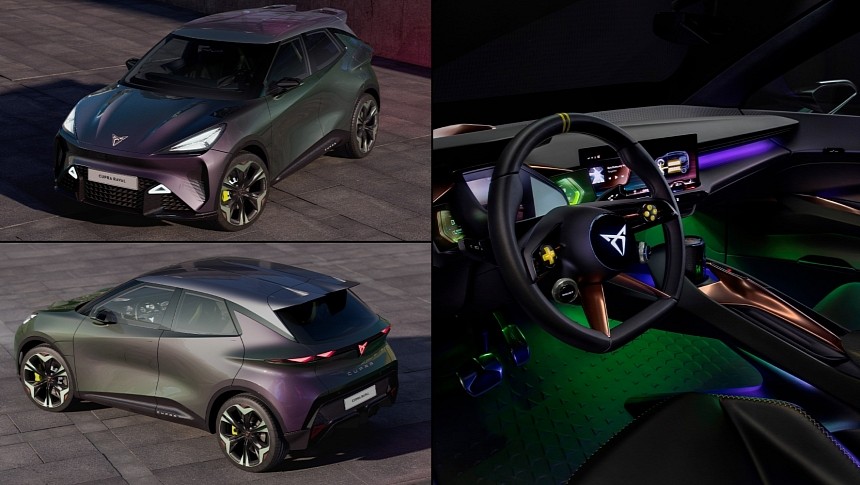Cupra, which means copper in Latin, was originally known as SEAT Sport. The Spanish automaker's performance-oriented subsidiary succeeded the Special Vehicles department. A standalone brand since 2018, the Martorell-based subsidiary is steadily building its portfolio of passenger vehicles. The emphasis is on EVs, a transition shared by all of the Volkswagen Group's automotive marques.
According to hearsay, SEAT may ditch automobiles entirely after 2030. It's highly possible for the Spanish automaker to become an urban mobility brand, leaving Cupra to soldier on alone. A very important model for Cupra is the series-production version of the UrbanRebel Concept, a subcompact hatchback with crossover looks. The road-going car will be known as the Raval, with production starting in 2025.
What does Raval mean? For some reason or another, Cupra named this urban cruiser after a neighborhood in Barcelona. Raval comes from the Arabic word Rabad, which translates to… uhm… suburb.
Chevrolet Suburban, anyone? Jokes aside, Raval does match Cupra's youth-oriented identity within the Volkswagen Group. Aimed at young customers – especially Gen Z – the Raval is based on the MEB Small platform for small electric vehicles. SEAT has committed 3 billion euros (approximately 3.275 billion dollars at current exchange rates) for the Martorell plant's changeover to electric vehicle production.
The UrbanRebel Concept that previews the real thing is 4,080 millimeters (160.6 inches) long and measures 2,600 millimeters (102.4 inches) between the front and rear axles. By comparison, the internal combustion-engined Ibiza is listed at 4,059 millimeters (159.8 inches) and 2,564 millimeters (100.9 inches), respectively. The footprint may be roughly the same, but due to the lack of a combustion engine, there's more space for both passengers and luggage in the Raval.
Not exactly a coincidence, the Volkswagen ID.2all Concept also measures 2.6 meters in wheelbase. It can reach 100 kilometers per hour (62 miles per hour) in less than 7 seconds thanks to a front-mounted electric motor. Why did Volkswagen switch to front-wheel drive rather than giving the ID.2 rear-wheel drive à la the ID.3?
The obvious answer is luggage capacity, with the ID.2all Concept promising 490 liters (approximately 17.3 cubic feet) with the rear seats in their normal position. That's a huge volume for a subcompact, dwarfing even the Golf by a considerable margin. The compact-sized hatchback can take no more than 380 liters (13.4 cubic feet).
Volkswagen Group subsidiary Skoda has also confirmed that it's developing a small electric hatchback with SUV styling, a Skoda-branded sibling for the ID.2 and Raval. All three will be manufactured in Martorell.
Back when the ID.3 was preparing for its grand reveal, Volkswagen famously described it as its third revolution after the Beetle and Golf. MEB-based vehicles sell pretty well across the world, including the United States and China. But with the introduction of a family of subcompact EVs, the Volkswagen Group will truly become a force to be reckoned with in the EV space.
What does Raval mean? For some reason or another, Cupra named this urban cruiser after a neighborhood in Barcelona. Raval comes from the Arabic word Rabad, which translates to… uhm… suburb.
Chevrolet Suburban, anyone? Jokes aside, Raval does match Cupra's youth-oriented identity within the Volkswagen Group. Aimed at young customers – especially Gen Z – the Raval is based on the MEB Small platform for small electric vehicles. SEAT has committed 3 billion euros (approximately 3.275 billion dollars at current exchange rates) for the Martorell plant's changeover to electric vehicle production.
The UrbanRebel Concept that previews the real thing is 4,080 millimeters (160.6 inches) long and measures 2,600 millimeters (102.4 inches) between the front and rear axles. By comparison, the internal combustion-engined Ibiza is listed at 4,059 millimeters (159.8 inches) and 2,564 millimeters (100.9 inches), respectively. The footprint may be roughly the same, but due to the lack of a combustion engine, there's more space for both passengers and luggage in the Raval.
Not exactly a coincidence, the Volkswagen ID.2all Concept also measures 2.6 meters in wheelbase. It can reach 100 kilometers per hour (62 miles per hour) in less than 7 seconds thanks to a front-mounted electric motor. Why did Volkswagen switch to front-wheel drive rather than giving the ID.2 rear-wheel drive à la the ID.3?
The obvious answer is luggage capacity, with the ID.2all Concept promising 490 liters (approximately 17.3 cubic feet) with the rear seats in their normal position. That's a huge volume for a subcompact, dwarfing even the Golf by a considerable margin. The compact-sized hatchback can take no more than 380 liters (13.4 cubic feet).
Volkswagen Group subsidiary Skoda has also confirmed that it's developing a small electric hatchback with SUV styling, a Skoda-branded sibling for the ID.2 and Raval. All three will be manufactured in Martorell.
Back when the ID.3 was preparing for its grand reveal, Volkswagen famously described it as its third revolution after the Beetle and Golf. MEB-based vehicles sell pretty well across the world, including the United States and China. But with the introduction of a family of subcompact EVs, the Volkswagen Group will truly become a force to be reckoned with in the EV space.








